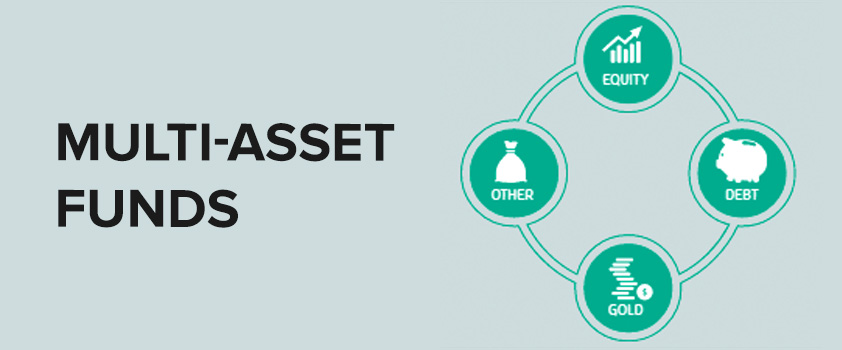Multiasset Fund of Funds
2 Min Read
How to reap the benefits of constant volatility in different asset class by investing in single product? Do not keep all your eggs in one basket” is often said when it comes to talking about the need for diversification in one’s investments. However, the moot point to understand here is why one needs to diversify investments across asset classes.

In calendar year 2008, a time of global financial crisis, gold delivered 28.61% return whereas both Indian and global equities were deep in red, down 56.54 % and 30.27% respectively. However, in 2009, equities across the globe rebounded and delivered returns to the tune of 90.96% (domestic) and 25.72% (global). Gold too delivered positive returns of 22.42%. Similarly, in 2012, while equities in general delivered 17% plus returns, gold was at 12.92%. One year hence, gold generated negative return of 7.90% and equities too diverged with global equity generating 35.76% while Indian equity was languishing at 4.82%. This clearly shows that winners in terms of asset classes keep on changing every other year and the co-relation between all these asset classes too is minimal. So, the optimal approach to make the most is through prudent asset allocation and rebalancing as and when required.
Tax Due Dates and Updates App

Install now
Asset Class Mix
The major investment asset classes under consideration is equity, debt, gold and real estate. Real estate is not relevant for an average investor as it requires huge one-time investment. Along with these, over the past few years, a fourth asset class in the form of global equity has taken shape. Indian investors have been increasingly taking exposure to innovative global companies such as Apple, Meta, Netflix, Microsoft etc. through international funds or ETFs offered by domestic fund houses.
How to go about Asset Allocation?
To optimally diversify a portfolio, you can consider investing across all the four asset classes. However, owing to limited understanding about the nuances of various asset classes, we tend to stick to those asset classes the asset classes we understand well. The other alternative is that we invest in a mutual fund scheme which does this for us. Within each asset class, there are a variety of offerings one can choose from. For example: Within domestic equities, there are market capitalization based funds, thematic or sectoral funds and even smart beta funds.
In case one invests either directly or through mutual fund schemes in different asset classes, one has to periodically review and take a call to increase or decrease exposure in specific asset category based on its likely future performance. There are two problems with this strategy. One, it is difficult for an average investor to correctly anticipate future performance of specific asset category and two, even if one is able to do it correctly every time, one has to bear capital gains tax while rebalancing. Over long term, the tax incurred is likely to cause a dent in the overall investment experience.
Learn All Skills to Grow Practice, 100s of FREE Videos

Subscribe to Youtube
Optimal Solution
There are two ways one can address these challenges. First, invest in a mutual fund scheme which invests in all of these asset classes directly or second, invest in a fund of fund which invest in schemes available across these asset classes. The second option has better potential to get you better returns as this will help you reap the benefit of focused expertise of the respective fund managers of the underlying scheme.
For addressing the challenges related to optimal asset allocation, ICICI Prudential has launched Passive Multi- Asset Fund of Funds, a scheme which is designed to invest in all four asset categories discussed earlier with some limits assigned to each of the asset classes. As a result, the overall volatility is expected to much lower than investing in a single asset class. Moreover, tactical calls taken by the fund manager from time to time is likely to help generate better risk adjusted returns with lower volatility in the long run. Since this is a fund of fund, the expenses will be capped at 1%.
Taxation
For taxation purpose, fund of fund is treated as a debt fund. Any profits on sale/redemption of units will qualify as long term if held for more than 36 months. The long term capital gains will be taxed at flat 20% after indexation whereas short term capital gains will be included in your regular income and will get taxed at the slab rate applicable to you.
Disclaimer:The information contained in this website is for general information purposes only. The information is provided by PracticeGuru and while we endeavour to keep the information up to date and correct, we make no representations or warranties of any kind, express or implied, about the completeness, accuracy, reliability, suitability or availability with respect to the website or the information, products, services, or related graphics contained on the website for any purpose. Any reliance you place on such information is therefore strictly at your own risk. In no event will we be liable for any loss or damage including without limitation, indirect or consequential loss or damage, or any loss or damage whatsoever arising from loss of data or profits arising out of, or in connection with, the use of this website.
You may send in your articles on [email protected] . We will publish them on our website with credit to you.
Comments
Now ask question in any of the Categories of finance, tax and related areas and get Answers from Experts on practiceguru.pro
Ask Questions


